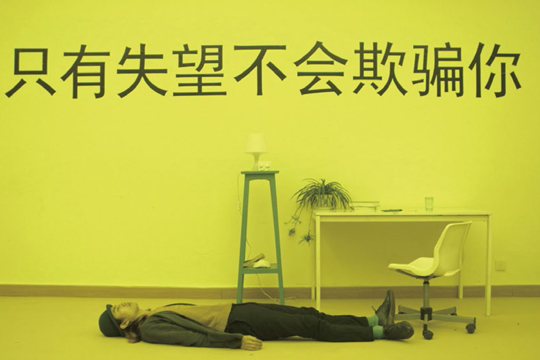CHEN ZHOU: I AM NOT NOT NOT CHEN ZHOU
| July 25, 2013 | Post In LEAP 21

Courtesy of the artist and Magician Space
Chen Zhou holds a knife to his wrist but doesn’t press down. This event early in his new film seems to express the artist’s present state more precisely than anything else—“I want to, but I can’t.” In Chen’s previous work Spanking the Maid, the same “inability” can be found, only on this occasion, the identity of the artist has been explicitly revealed, the metaphor as a rhetorical method has been dropped, and the lead role—hitherto concealed—has been set free. Not only does he now speak directly, he chatters incessantly, repeatedly negating himself but always full of conviction—perhaps he is no longer an artist, but he’ll always be Chen Zhou.
The frail interactivity between this exhibition and its audience, and its fabricated cinema-like viewing conditions together form a contradictory pair. Its content simultaneously extremely private and widely publicized, its stance is thus equivocal: at one extreme it is lofty and aloof, and at the other, it appears to actively seek admiration and participation. This contradictory and ever-wavering character persists throughout. The dialogue performed by the identical twin brothers in the film is drawn from everyday conversations between Chen Zhou and his artist friends. Chen does not conceal this fact. Several of his friends appear during the film, and in photographs in the adjacent yellow-lit room, so do their images. The dialogue is full of boredom and frustration, convincingly recreated as an exposure of the confusion and discontent of the artist—or more specifically, of the young group of artists to which Chen belongs. With this exhibition, it also seems that Chen has departed from his previous works, which relied heavily on individual emotions, tastes, and formal language.
But what has the artist actually deserted? And what new things is he preparing? During the course of this “transformation,” what kind of position will he assume? From this new film, we can tell that Chen Zhou’s love affair with form is ongoing; chunks of fragmented dialogue pad out gaps in conversation, and all flippant language is left in. This kind of language, alongside the doubt and disruption the artist constructs with rhetoric, generates a conflict that reveals two conflicting qualities of the film—critique and abandon.
However, in the same way, the conversations of the insane characters in the film don’t actually interfere with its seemingly erratic yet sharp dialogue—the “artist,” unable to detach himself from the insanity, and incapable of returning to a “natural” state, is forever trapped within his own indecipherable riddles. “Why must I make art?” is the artist’s eternal question to himself, but is the target of this question actually the “artist,” or the individual who makes art? An especially noticeable element of the film is its use of props—as the fabricated set produces a theatrical atmosphere, subtle props pull the characters back into life—which never step outside of the artist’s life and its everyday, tangible activities. To call all this self-infatuation would perhaps be excessively severe, but when we discuss art, we certainly do not expect to be confronted by such a private, seemingly circuitous logic.
At the entrance of the exhibition, a preface written by its curator Su Wei performs a particularly interesting role, “I couldn’t help but be pulled into Chen Zhou’s predicament.” At this point the spectator begins to be pulled into the same “predicament”—in this yellow space, text, image, and film together form a composition both exquisite and isolated.

